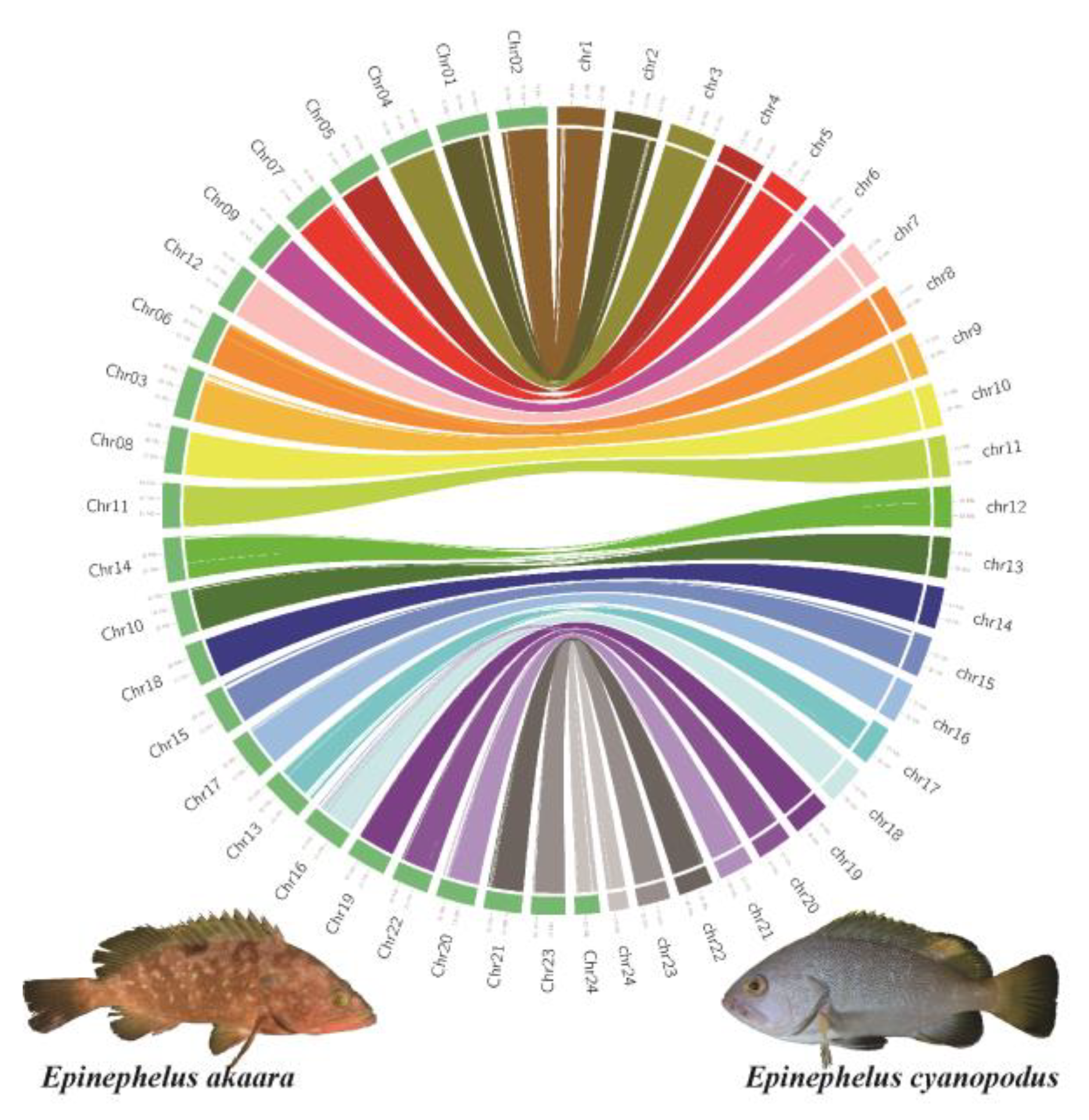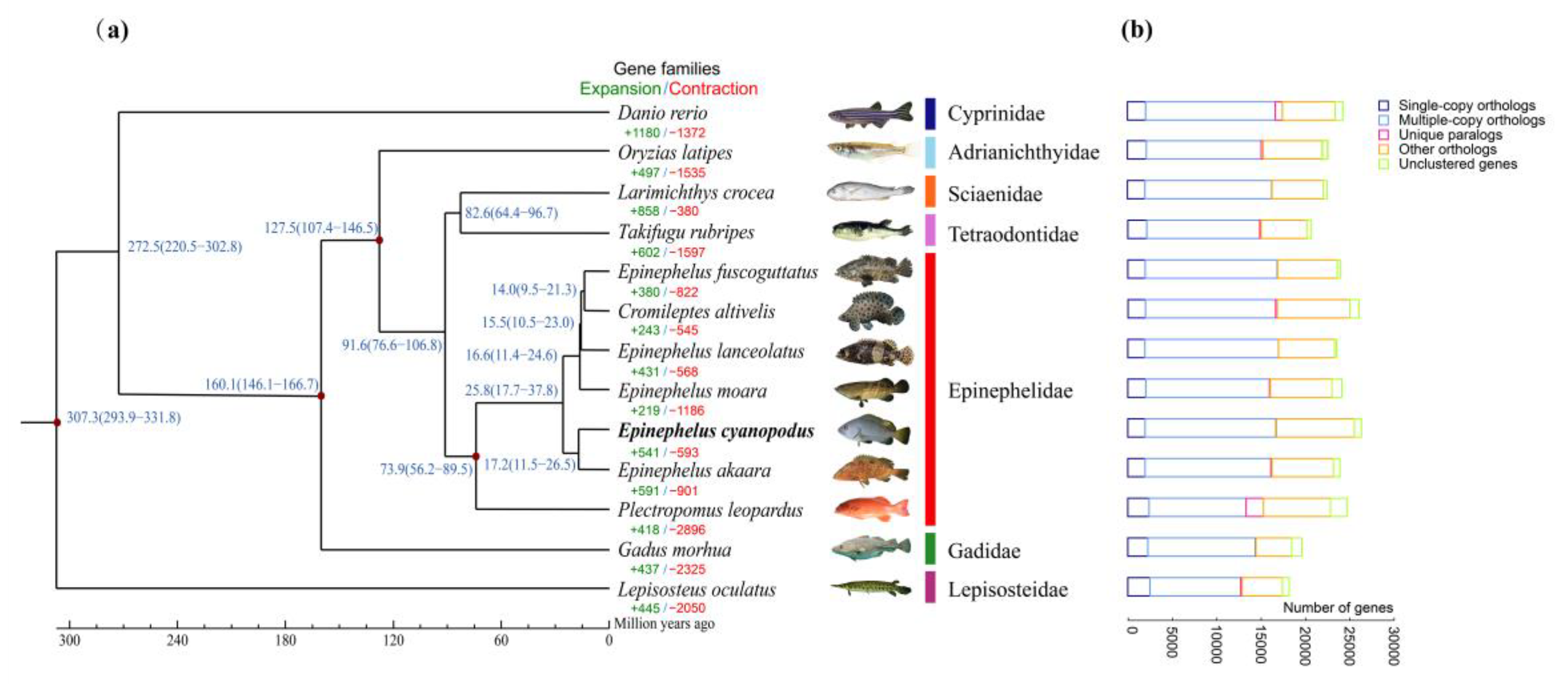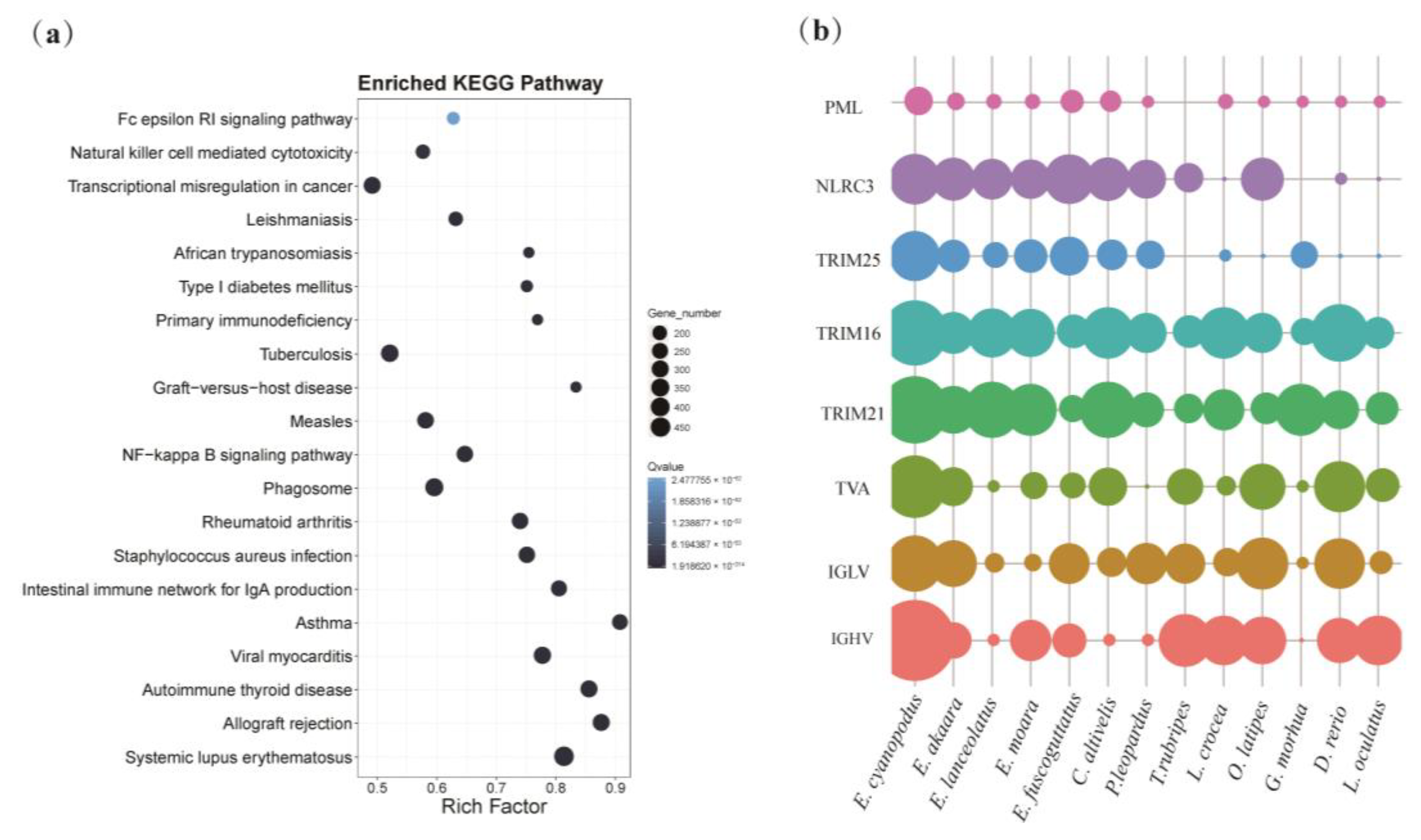Chromosome-Level Genome Assembly of the Speckled Blue Grouper (Epinephelus cyanopodus) Provides Insight into Its Adaptive Evolution
Abstract
:Simple Summary
Abstract
1. Introduction
2. Materials and Methods
2.1. Sample Collection and Nucleic Acid Extraction
2.2. Library Construction and Genome Sequencing
2.3. Genome Assembly and Assessment
2.4. Genome Annotation
2.5. Genome Synteny Analysis
2.6. Comparative Genomic Analysis
2.7. Identification of Positive Selection Genes
3. Results and Discussion
3.1. Genome Assembly and Evaluation
3.2. Genome Annotation
3.3. Chromosome Synteny Analysis
3.4. Divergence Time Estimation
3.5. Gene Family Expansion
3.6. Identification of Positively Selected Genes
4. Conclusions
Supplementary Materials
Author Contributions
Funding
Institutional Review Board Statement
Informed Consent Statement
Data Availability Statement
Conflicts of Interest
References
- Ding, S.X.; Liu, Q.H.; Wu, H.H.; Qu, M. A review of research advances on the biology and artificial breeding of groupers. J. Fish. Sci. China 2018, 25, 737–752. [Google Scholar] [CrossRef]
- Craig, M.T.; de Mitcheson, Y.S.; Heemstra, P.C. Groupers of the World: A Field and Market Guide; NISC (Pty) Ltd.: Grahamstown, South Africa, 2011. [Google Scholar]
- Wu, H.; Qu, M.; Lin, H.; Tang, W.; Ding, S. Epinephelus tankahkeei, a new species of grouper (Teleostei, Perciformes, Epinephelidae) from the South China Sea. J. ZooKeys 2020, 933, 125–137. [Google Scholar] [CrossRef] [PubMed]
- Frable, B.W.; Tucker, S.J.; Walker, H. A new species of grouper, Epinephelus craigi (Perciformes: Epinephelidae), from the South China Sea. J. Ichthyol. Res. 2019, 66, 215–224. [Google Scholar] [CrossRef]
- Randall, J.E.; Bogorodsky, S.V.; Krupp, F.; Rose, J.M.; Fricke, R. Epinephelus geoffroyi (Klunzinger, 1870) (Pisces: Serranidae), a valid species of grouper endemic to the Red Sea and Gulf of Aden. Zootaxa 2013, 3641, 524–532. [Google Scholar] [CrossRef] [Green Version]
- Cao, X.; Wu, H.; Zhang, H.; Wu, L.; Ding, S. Epinephelus rankini Whitley, 1945, a valid species of grouper (Teleostei, Perciformes, Epinephelidae) from Western Australia and southeast Indonesia. Biodivers. Data J. 2022, 10, e90472. [Google Scholar] [CrossRef]
- Ma, K.Y.; Craig, M.T.; Choat, J.H.; van Herwerden, L. The historical biogeography of groupers: Clade diversification patterns and processes. Mol. Phylogenetics Evol. 2016, 100, 21–30. [Google Scholar] [CrossRef]
- Froese, R.; Pauly, D. FishBase, Version (11/2022). 2022. Available online: https://www.fishbase.org (accessed on 8 November 2022).
- Heemstra, P.C.; Randall, J.E. FAO Species Catalogue. v16: Groupers of the World (Family Serranidae, Subfamily Epinephelinae); FAO: Geneva, Switzerland, 1993. [Google Scholar]
- Chen, Y.; Chen, Y.; Shi, C.; Huang, Z.; Zhang, Y.; Li, S.; Li, Y.; Ye, J.; Yu, C.; Li, Z. SOAPnuke: A MapReduce acceleration-supported software for integrated quality control and preprocessing of high-throughput sequencing data. J. Gigasci. 2018, 7, 1–6. [Google Scholar] [CrossRef] [Green Version]
- Altschul, S.F.; Gish, W.; Miller, W.; Myers, E.W.; Lipman, D.J. Basic local alignment search tool. J. Mol. Biol. 1990, 215, 403–410. [Google Scholar] [CrossRef]
- Li, R.; Zhu, H.; Ruan, J.; Qian, W.; Fang, X.; Shi, Z.; Li, Y.; Li, S.; Shan, G.; Kristiansen, K. De novo assembly of human genomes with massively parallel short read sequencing. J. Genome Res. 2010, 20, 265–272. [Google Scholar] [CrossRef] [Green Version]
- Marçais, G.; Kingsford, C. A fast, lock-free approach for efficient parallel counting of occurrences of k-mers. J. Bioinform. 2011, 27, 764–770. [Google Scholar] [CrossRef]
- Vurture, G.W.; Sedlazeck, F.J.; Nattestad, M.; Underwood, C.J.; Fang, H.; Gurtowski, J.; Schatz, M.C. GenomeScope: Fast reference-free genome profiling from short reads. Bioinformatics 2017, 33, 2202–2204. [Google Scholar] [CrossRef] [PubMed] [Green Version]
- Xiao, C.L.; Chen, Y.; Xie, S.Q.; Chen, K.N.; Wang, Y.; Han, Y.; Luo, F.; Xie, Z. MECAT: Fast mapping, error correction, and de novo assembly for single-molecule sequencing reads. Nat. Methods 2017, 14, 1072–1074. [Google Scholar] [CrossRef] [PubMed]
- Walker, B.J.; Abeel, T.; Shea, T.; Priest, M.; Abouelliel, A.; Sakthikumar, S.; Cuomo, C.A.; Zeng, Q.; Wortman, J.; Young, S.K.; et al. Pilon: An integrated tool for comprehensive microbial variant detection and genome assembly improvement. PLoS ONE 2014, 9, e112963. [Google Scholar] [CrossRef] [PubMed]
- Durand, N.C.; Shamim, M.S.; Machol, I.; Rao, S.S.; Huntley, M.H.; Lander, E.S.; Aiden, E.L. Juicer Provides a One-Click System for Analyzing Loop-Resolution Hi-C Experiments. Cell Syst. 2016, 3, 95–98. [Google Scholar] [CrossRef] [Green Version]
- Dudchenko, O.; Batra, S.S.; Omer, A.D.; Nyquist, S.K.; Hoeger, M.; Durand, N.C.; Shamim, M.S.; Machol, I.; Lander, E.S.; Aiden, A.P. De novo assembly of the Aedes aegypti genome using Hi-C yields chromosome-length scaffolds. J. Sci. 2017, 356, 92. [Google Scholar] [CrossRef] [Green Version]
- Simao, F.A.; Waterhouse, R.M.; Ioannidis, P.; Kriventseva, E.V.; Zdobnov, E.M. BUSCO: Assessing genome assembly and annotation completeness with single-copy orthologs. Bioinformatics 2015, 31, 3210–3212. [Google Scholar] [CrossRef] [Green Version]
- Zeng, L.; Kortschak, R.D.; Raison, J.M.; Bertozzi, T.; Adelson, D.L. Superior ab initio identification, annotation and characterisation of TEs and segmental duplications from genome assemblies. PLoS ONE 2018, 13, e0193588. [Google Scholar] [CrossRef] [Green Version]
- Xu, Z.; Wang, H. LTR_FINDER: An efficient tool for the prediction of full-length LTR retrotransposons. Nucleic Acids Res. 2007, 35, W265–W268. [Google Scholar] [CrossRef] [Green Version]
- Chen, N. Using Repeat Masker to identify repetitive elements in genomic sequences. Curr. Protoc. Bioinform. 2004, 5, 4–10. [Google Scholar] [CrossRef]
- Bao, W.; Kojima, K.K.; Kohany, O. Repbase Update, a database of repetitive elements in eukaryotic genomes. Mob. DNA 2015, 6, 11. [Google Scholar] [CrossRef]
- Stanke, M.; Waack, S. Gene prediction with a hidden Markov model and a new intron submodel. Bioinformatics 2003, 19 (Suppl. 2), 215–225. [Google Scholar] [CrossRef] [PubMed] [Green Version]
- Birney, E.; Clamp, M.; Durbin, R. GeneWise and genomewise. J. Genome Res. 2004, 14, 988–995. [Google Scholar] [CrossRef] [PubMed] [Green Version]
- Elsik, C.G.; Mackey, A.J.; Reese, J.T.; Milshina, N.V.; Roos, D.S.; Weinstock, G.M. Creating a honey bee consensus gene set. Genome Biol. 2007, 8, R13. [Google Scholar] [CrossRef] [PubMed] [Green Version]
- Mitchell, A.L.; Attwood, T.K.; Babbitt, P.C.; Blum, M.; Bork, P.; Bridge, A.; Brown, S.D.; Chang, H.Y.; El-Gebali, S.; Fraser, M.I.; et al. InterPro in 2019: Improving coverage, classification and access to protein sequence annotations. Nucleic Acids Res. 2019, 47, D351–D360. [Google Scholar] [CrossRef] [Green Version]
- Kanehisa, M.; Goto, S. KEGG: Kyoto encyclopedia of genes and genomes. Nucleic Acids Res. 2000, 28, 27–30. [Google Scholar] [CrossRef]
- Bairoch, A.; Apweiler, R. The SWISS-PROT protein sequence database and its supplement TrEMBL in 2000. Nucleic Acids Res. 2000, 28, 45–48. [Google Scholar] [CrossRef]
- Harris, M.A.; Clark, J.; Ireland, A.; Lomax, J.; Ashburner, M.; Foulger, R.; Eilbeck, K.; Lewis, S.; Marshall, B.; Mungall, C.; et al. The Gene Ontology (GO) database and informatics resource. Nucleic Acids Res. 2004, 32, D258–D261. [Google Scholar] [CrossRef] [Green Version]
- O’Donovan, C.; Martin, M.J.; Gattiker, A.; Gasteiger, E.; Bairoch, A.; Apweiler, R. High-quality protein knowledge resource: SWISS-PROT and TrEMBL. Brief. Bioinform. 2002, 3, 275–284. [Google Scholar] [CrossRef]
- Li, H.; Coghlan, A.; Ruan, J.; Coin, L.J.; Heriche, J.K.; Osmotherly, L.; Li, R.; Liu, T.; Zhang, Z.; Bolund, L.; et al. TreeFam: A curated database of phylogenetic trees of animal gene families. Nucleic Acids Res. 2006, 34, D572–D580. [Google Scholar] [CrossRef]
- Edgar, R.C. MUSCLE: Multiple sequence alignment with high accuracy and high throughput. Nucleic Acids Res. 2004, 32, 1792–1797. [Google Scholar] [CrossRef]
- Stamatakis, A.; Ludwig, T.; Meier, H. RAxML-III: A fast program for maximum likelihood-based inference of large phylogenetic trees. Bioinformatics 2005, 21, 456–463. [Google Scholar] [CrossRef] [PubMed] [Green Version]
- Yang, Z. PAML 4: Phylogenetic analysis by maximum likelihood. Mol. Biol. Evol. 2007, 24, 1586–1591. [Google Scholar] [CrossRef] [PubMed] [Green Version]
- De Bie, T.; Cristianini, N.; Demuth, J.P.; Hahn, M.W. CAFE: A computational tool for the study of gene family evolution. Bioinformatics 2006, 22, 1269–1271. [Google Scholar] [CrossRef] [PubMed] [Green Version]
- Buchfink, B.; Chao, X.; Huson, D.H. Fast and sensitive protein alignment using DIAMOND. Nat. Methods 2015, 12, 59–60. [Google Scholar] [CrossRef]
- Talavera, G.; Castresana, J. Improvement of phylogenies after removing divergent and ambiguously aligned blocks from protein sequence alignments. Syst. Biol. 2007, 56, 564–577. [Google Scholar] [CrossRef] [Green Version]
- Yang, Y.; Wu, L.N.; Chen, J.F.; Wu, X.; Xia, J.H.; Meng, Z.N.; Liu, X.C.; Lin, H.R. Whole-genome sequencing of leopard coral grouper (Plectropomus leopardus) and exploration of regulation mechanism of skin color and adaptive evolution. Zool Res. 2020, 41, 328–340. [Google Scholar] [CrossRef]
- Yang, Y.; Wang, T.; Chen, J.; Wu, L.; Wu, X.; Zhang, W.; Luo, J.; Xia, J.; Meng, Z.; Liu, X. Whole-genome sequencing of brown-marbled grouper (Epinephelus fuscoguttatus) provides insights into adaptive evolution and growth differences. Mol. Ecol. Resour. 2022, 22, 711–723. [Google Scholar] [CrossRef]
- Ge, H.; Lin, K.; Shen, M.; Wu, S.; Wang, Y.; Zhang, Z.; Wang, Z.; Zhang, Y.; Huang, Z.; Zhou, C.; et al. De novo assembly of a chromosome-level reference genome of red-spotted grouper (Epinephelus akaara) using nanopore sequencing and Hi-C. Mol. Ecol. Resour. 2019, 19, 1461–1469. [Google Scholar] [CrossRef] [Green Version]
- Zhou, Q.; Gao, H.; Zhang, Y.; Fan, G.; Xu, H.; Zhai, J.; Xu, W.; Chen, Z.; Zhang, H.; Liu, S.; et al. A chromosome-level genome assembly of the giant grouper (Epinephelus lanceolatus) provides insights into its innate immunity and rapid growth. Mol. Ecol. Resour. 2019, 19, 1322–1332. [Google Scholar] [CrossRef]
- Zhou, Q.; Gao, H.; Xu, H.; Lin, H.; Chen, S. A Chromosomal-scale Reference Genome of the Kelp Grouper Epinephelus moara. Mar. Biotechnol. 2021, 23, 12–16. [Google Scholar] [CrossRef]
- Warren, W.C.; Boggs, T.E.; Borowsky, R.; Carlson, B.M.; Ferrufino, E.; Gross, J.B.; Hillier, L.; Hu, Z.; Keene, A.C.; Kenzior, A.; et al. A chromosome-level genome of Astyanax mexicanus surface fish for comparing population-specific genetic differences contributing to trait evolution. Nat. Commun 2021, 12, 1447. [Google Scholar] [CrossRef]
- Renema, W.; Bellwood, D.R.; Braga, J.C.; Bromfield, K.; Hall, R.; Johnson, K.G.; Lunt, P.; Meyer, C.P.; McMonagle, L.B.; Morley, R.J.; et al. Hopping hotspots: Global shifts in marine biodiversity. Science 2008, 321, 654–657. [Google Scholar] [CrossRef] [PubMed] [Green Version]
- Harris, R.M.; Hofmann, H.A. Seeing is believing: Dynamic evolution of gene families. Proc. Natl. Acad. Sci. USA 2015, 112, 1252–1253. [Google Scholar] [CrossRef] [Green Version]
- Uribe, C.; Folch, H.; Enriquez, R.; Moran, G. Innate and adaptive immunity in teleost fish: A review. Veterinární Med. 2011, 56, 486–503. [Google Scholar] [CrossRef] [Green Version]
- Meunier, E.; Broz, P. Evolutionary Convergence and Divergence in NLR Function and Structure. Trends Immunol. 2017, 38, 744–757. [Google Scholar] [CrossRef] [PubMed]
- Chang, M.X.; Xiong, F.; Wu, X.M.; Hu, Y.W. The expanding and function of NLRC3 or NLRC3-like in teleost fish: Recent advances and novel insights. Dev. Comp. Immunol. 2021, 114, 103859. [Google Scholar] [CrossRef] [PubMed]
- Vunjak, M.; Versteeg, G.A. TRIM proteins. Curr. Biol. 2019, 29, R42–R44. [Google Scholar] [CrossRef] [Green Version]
- Mashoof, S.; Criscitiello, M.F. Fish Immunoglobulins. Biology 2016, 5, 45. [Google Scholar] [CrossRef] [Green Version]
- Wei, G. Preliminary study on the diversity of immunoglobulin V region and the function of Aicda gene of Cyprinus carpio L. Master’s Thesis, Shandong Nomal University, Jinan, China, 2022. [Google Scholar]
- Krangel, M.S. Mechanics of T cell receptor gene rearrangement. Curr. Opin. Immunol. 2009, 21, 133–139. [Google Scholar] [CrossRef] [Green Version]
- Merle, N.S.; Church, S.E.; Fremeaux-Bacchi, V.; Roumenina, L.T. Complement System Part I—Molecular Mechanisms of Activation and Regulation. Front. Immunol. 2015, 6, 262. [Google Scholar] [CrossRef]
- Holland, M.C.; Lambris, J.D. The complement system in teleosts. Fish Shellfish Immunol. 2002, 12, 399–420. [Google Scholar] [CrossRef] [PubMed] [Green Version]
- Tang, Y.Y.; Li, Y.T.; Zha, X.H.; Zhang, D.Z.; Tang, B.P.; Liu, Q.N.; Jiang, S.H.; Dai, L.S. A complement factor I (CFI) gene mediates innate immune responses in yellow catfish Pelteobagrus fulvidraco. Genomics 2021, 113, 1257–1264. [Google Scholar] [CrossRef] [PubMed]
- O’Farrell, C.; Vaghefi, N.; Cantonnet, M.; Buteau, B.; Boudinot, P.; Benmansour, A. Survey of transcript expression in rainbow trout leukocytes reveals a major contribution of interferon-responsive genes in the early response to a rhabdovirus infection. J. Virol. 2002, 76, 8040–8049. [Google Scholar] [CrossRef] [PubMed] [Green Version]
- Briukhovetska, D.; Dorr, J.; Endres, S.; Libby, P.; Dinarello, C.A.; Kobold, S. Interleukins in cancer: From biology to therapy. Nat. Rev. Cancer 2021, 21, 481–499. [Google Scholar] [CrossRef]
- Whillock, A.L.; Ybarra, T.K.; Bishop, G.A. TNF receptor-associated factor 3 restrains B-cell receptor signaling in normal and malignant B cells. J. Biol. Chem. 2021, 296, 100465. [Google Scholar] [CrossRef]
- Twibell, R.G.; Wilson, R.P. Preliminary evidence that cholesterol improves growth and feed intake of soybean meal-based diets in aquaria studies with juvenile channel catfish, Ictalurus punctatus. Aquaculture 2004, 236, 539–546. [Google Scholar] [CrossRef]
- Deng, J.; Bi, B.; Kang, B.; Kong, L.; Wang, Q.; Zhang, X. Improving the growth performance and cholesterol metabolism of rainbow trout (Oncorhynchus mykiss) fed soyabean meal-based diets using dietary cholesterol supplementation. Br. J. Nutr. 2013, 110, 29–39. [Google Scholar] [CrossRef] [Green Version]
- Liu, X. Sodium Acetate Stimulates the Fat Deposition by Stimulating the Fish Food Intake and the Secretion of Insulin. Master’s Thesis, Chinese Academy of Agricultural Sciences, Beijing, China, 2018. [Google Scholar]
- Ridley, A. Rho GTPases: Integrating integrin signaling. J. Cell Biol. 2000, 150, F107–F109. [Google Scholar] [CrossRef]
- Drosten, M.; Dhawahir, A.; Sum, E.Y.; Urosevic, J.; Lechuga, C.G.; Esteban, L.M.; Castellano, E.; Guerra, C.; Santos, E.; Barbacid, M. Genetic analysis of Ras signalling pathways in cell proliferation, migration and survival. EMBO J. 2010, 29, 1091–1104. [Google Scholar] [CrossRef]




| Assembly and Annotation Metrics | Number or Percentag |
|---|---|
| Number of contigs | 458 |
| Total Length of Contig(bp) | 998,645,601 |
| Contigs N50 (bp) | 5,850,290 |
| Contigs N90 (bp) | 1,343,332 |
| Maximum length of contig (bp) | 31,638,094 |
| GC content (%) | 41.13% |
| Scaffold N50 (bp) | 41,979,993 |
| Scaffold N90 (bp) | 36,023,923 |
| Hi-C anchored ratio | 99.70% |
| Gene number | 26,337 |
| Genome BUSCO | |
| Complete BUSCOs (C) | 95.8% |
| Complete and single-copy BUSCOs (S) | 93.4% |
| Complete and duplicated BUSCOs (D) | 2.4% |
| Fragmented BUSCOs (F) | 2.1% |
| Missing BUSCOs (M) | 2.1% |
| Gene set BUSCO | |
| Complete BUSCOs (C) | 94.20% |
| Complete and single-copy BUSCOs (S) | 90.40% |
| Complete and duplicated BUSCOs (D) | 3.80% |
| Fragmented BUSCOs (F) | 4.00% |
| Missing BUSCOs (M) | 1.80% |
| Gene Set | Gene Numbers | Gene Length (bp) | CDS Length (bp) | Intron Length (bp) | Exon Length (bp) | Exons per Gene | |
|---|---|---|---|---|---|---|---|
| De novo | Augustus | 35,837 | 13,973.06 | 1299.72 | 1980.92 | 176 | 7.4 |
| Homolog | Larimichthys crocea | 23,855 | 25,019.98 | 1660.45 | 2792.69 | 177 | 9.36 |
| Takifugu rubripes | 21,356 | 28,138.59 | 1592.36 | 3365.60 | 179 | 8.89 | |
| Oreochromis niloticus | 28,135 | 48,902.73 | 1654.82 | 6417.90 | 198 | 8.36 | |
| Oryzias latipes | 22,967 | 32,996.88 | 1665.46 | 4012.74 | 189 | 8.81 | |
| Epinephelus akaara | 26,107 | 23,122.33 | 1708.31 | 2295.96 | 165 | 10.33 | |
| Epinephelus fuscoguttatus | 26,333 | 21,472.99 | 1684.42 | 2248.34 | 172 | 9.8 | |
| Epinephelus lanceolatus | 26,129 | 20,700.34 | 1738.50 | 2138.27 | 176 | 9.87 | |
| Epinephelus moara | 26,847 | 19,858.37 | 1593.64 | 2229.24 | 173 | 9.19 | |
| Plectropomus leopardus | 26,178 | 79,013.83 | 1656.29 | 9731.50 | 185 | 8.95 | |
| Transcript | Stringtie & Transdecoder | 50,143 | 20,453.71 | 1045.25 | 499.54 | 230 | 4.55 |
| GLEAN | 26,337 | 17,793.40 | 1648.06 | 1937.65 | 177 | 9.33 |
| Type | Copy Number | Average | Total | % of | |
|---|---|---|---|---|---|
| Length(bp) | Length(bp) | Genome | |||
| rRNA | rRNA | 1181 | 136.57 | 161,293 | 0.0161 |
| 18S | 180 | 154.94 | 27,890 | 0.0028 | |
| 28S | 199 | 206.02 | 40,997 | 0.0041 | |
| 5.8S | 11 | 107.27 | 1180 | 0.0001 | |
| 5S | 791 | 115.33 | 91,226 | 0.0091 | |
| snRNA | snRNA | 473 | 134 | 63,380 | 0.0063 |
| CD-box | 130 | 103.88 | 13,505 | 0.0014 | |
| HACA-box | 79 | 151.05 | 11,933 | 0.0012 | |
| splicing | 256 | 141.15 | 36,134 | 0.0036 | |
| miRNA | 466 | 85.17 | 39,687 | 0.004 | |
| tRNA | 1778 | 75.74 | 134,663 | 0.0135 |
Publisher’s Note: MDPI stays neutral with regard to jurisdictional claims in published maps and institutional affiliations. |
© 2022 by the authors. Licensee MDPI, Basel, Switzerland. This article is an open access article distributed under the terms and conditions of the Creative Commons Attribution (CC BY) license (https://creativecommons.org/licenses/by/4.0/).
Share and Cite
Cao, X.; Zhang, J.; Deng, S.; Ding, S. Chromosome-Level Genome Assembly of the Speckled Blue Grouper (Epinephelus cyanopodus) Provides Insight into Its Adaptive Evolution. Biology 2022, 11, 1810. https://doi.org/10.3390/biology11121810
Cao X, Zhang J, Deng S, Ding S. Chromosome-Level Genome Assembly of the Speckled Blue Grouper (Epinephelus cyanopodus) Provides Insight into Its Adaptive Evolution. Biology. 2022; 11(12):1810. https://doi.org/10.3390/biology11121810
Chicago/Turabian StyleCao, Xiaoying, Jiajun Zhang, Shunyun Deng, and Shaoxiong Ding. 2022. "Chromosome-Level Genome Assembly of the Speckled Blue Grouper (Epinephelus cyanopodus) Provides Insight into Its Adaptive Evolution" Biology 11, no. 12: 1810. https://doi.org/10.3390/biology11121810






